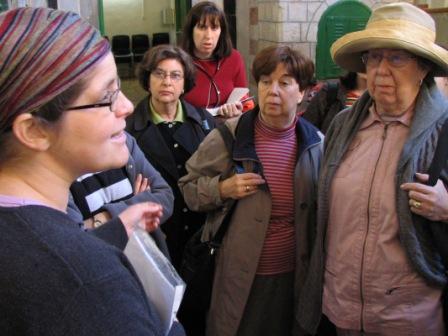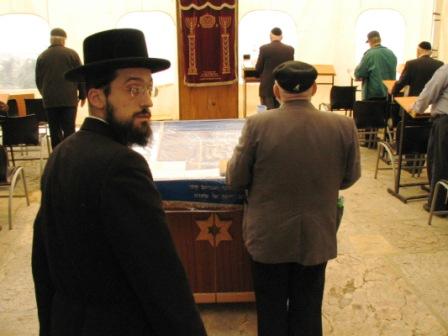 13:
Prayer at the Ibrahimi Mosque/Cave of Machpela, part 2 13:
Prayer at the Ibrahimi Mosque/Cave of Machpela, part 2 
By Skip Schiel
Photos: tour guide in synagogue, pray in synagogue
This is part two of prayer in Hebron because besides visiting the mosque, as I recounted last week, I visited the synagogue, the section of the Tomb complex that is reserved for Jewish people. Others—but no Muslims--are also allowed to enter, after subjecting themselves to a thorough search by the Border Police.
Earlier I’d happened upon a Jewish group from the US who was being guided by a voluble, articulate, energetic Israeli Jewish woman. This was at Beit Hadassah, a medical clinic for Jews and Arabs that was partially destroyed during a revolt and massacre by Hebron Arabs in 1929. They decimated the Jewish population which didn’t return for any significant period until after the 1967 war.
She spoke glowingly of the heroic retaking of Beit Hadassah, how women and children had snuck in and occupied it until the Israeli authorities eventually turned control over to Jewish groups. It is now a combination of shrine and museum, testimonial to Israeli Jewish courage and determination, stalwart returnees to lands they feel God himself promised to them.
I was attracted by this woman, her story, her belief, her passion, her commitment, and relished the opportunity to try to learn from one of the purveyors of the ideology that drives Jewish settlers. After all, Hebron is the site of some of the most adamant settlers, some 600 of them in the central city (with 6000 in an outlying settlement of Kiryat Arba), protected by some 2000 soldiers. The settlers live in a cluster of what they call communities or neighborhoods, what others call settlements or colonies. These are in the heart of Hebron , in fact, in the Old City .
When the tour left the shrine for the synagogue, I was tempted to curtail my look at the site and try to join the tour, perhaps asking permission to join, paying a fee, riding the bus to the next stop. I resisted, remained at Beit Hadassah, observed, read interpretive panels, photographed. And hoped the audio recording I’d made of her would later elucidate more detail of the settlers’ story.
What a surprise when later, traveling to the synagogue alone, I found the tour group. I rejoined, went with them to the prayer area with the men, and in my fashion--photographically--prayed. Then she shepherded us into a small alcove adjoining the tombs of Abraham and Sarah and there told a most intriguing story.
It was how the tombs were explored in modern times. First by a young girl who was recruited because of her narrow girth--she could fit thru the slender opening beneath the floor of the mosque. Second by a group of Jews who surreptitiously entered the tombs and--they claim--found bones and pottery from the period of Abraham and his successors.
Mid way thru this rapturous story she stopped and looked directly at me. I’d stayed within 2 meters of her the entire time, to best record sound and make photos. She stopped her story, said to me, “I don’t know who you are. You never asked permission to record me.”
She was polite. She was courteous. I feel she was compassionate. Her tone was imploring, not demanding. She could have booted me from the tour, embarrassing me further in front of my compatriots from the US . She allowed me to remain, I listened to the last of the story of how the tombs were--in some eyes--verified.
Most importantly however I discovered that she was saying, in coded language, lacing her message with Hebrew words that many seemed to understand--granted, I am surmising--that the Jews would eventually prevail. All would be theirs. The settlements are merely a first step in the process.
“ Tours of the Jewish community of Hebron ”
The story of the recovery of Beit Hadassah
The 1929 Hebron massacre
Settlement
|



